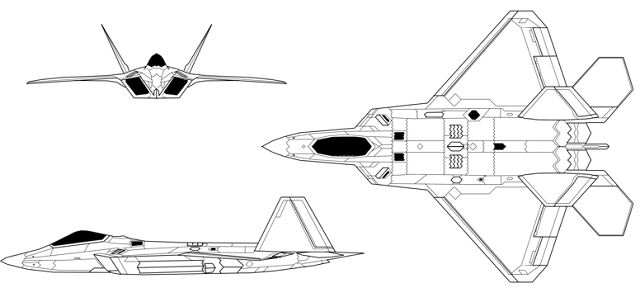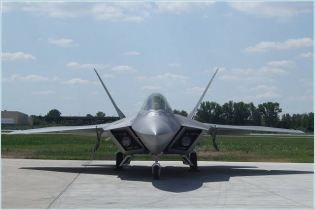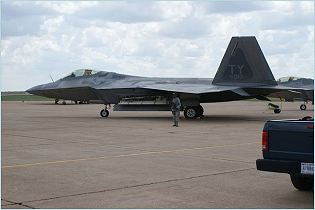F-22 Raptor
| a | ||||||||||||||||||||||
|
F-22 Raptor fifth-generation stealth fighter aircraft
|
||||||||||||||||||||||
 |
||||||||||||||||||||||
|
The F-22 Raptor is the Air Force's newest fighter aircraft. Its combination of stealth, supercruise, maneuverability, and integrated avionics, coupled with improved supportability, represents an exponential leap in warfighting capabilities. The Raptor performs both air-to-air and air-to-ground missions allowing full realization of operational concepts vital to the 21st century Air Force. The Advanced Tactical Fighter entered the Demonstration and Validation phase in 1986. The prototype aircraft (YF-22 and YF-23) both completed their first flights in late 1990. Ultimately the YF-22 was selected as best of the two and the engineering and manufacturing development effort began in 1991 with development contracts to Lockheed/Boeing (airframe) and Pratt & Whitney (engines). EMD included extensive subsystem and system testing as well as flight testing with nine aircraft at Edwards Air Force Base, Calif. The first EMD flight was in 1997 and at the completion of its flight test life this aircraft was used for live-fire testing. The program received approval to enter low rate initial production in 2001. Initial operational and test evaluation by the Air Force Operational Test and Evaluation Center was successfully completed in 2004. Based on maturity of design and other factors the program received approval for full rate production in 2005. Air Education and Training Command, Air Combat Command and Pacific Air Forces are the primary Air Force organizations flying the F-22. The aircraft designation was the F/A-22 for a short time before being renamed F-22A in December 2005. |
||||||||||||||||||||||
| Main Variants | ||||||||||||||||||||||
|
|
||||||||||||||||||||||
|
- YF-22A: pre-production version used for ATF testing and evaluation. Two were built.
- F-22A: single-seat production version. Was designated "F/A-22A" in early 2000s. - F-22B: planned two-seat variant, but was dropped in 1996 to save development costs. - Naval F-22 variant: a carrier-borne variant of the F-22 with swing-wings for the U.S. Navy's Navy Advanced Tactical Fighter (NATF) program to replace the F-14 Tomcat. Program was canceled in 1993. Former SoAF Donald Rice has called the possibility of the naval variant the deciding factor for his choice of the YF-22 over the YF-23 |
||||||||||||||||||||||
| Technical Data | ||||||||||||||||||||||
| Design | ||||||||||||||||||||||
|
The F-22's characteristics provide a synergistic effect ensuring F-22A lethality against all advanced air threats. The combination of stealth, integrated avionics and supercruise drastically shrinks surface-to-air missile engagement envelopes and minimizes enemy capabilities to track and engage the F-22 . The combination of reduced observability and supercruise accentuates the advantage of surprise in a tactical environment.
|
||||||||||||||||||||||
| Avionics and equipment | ||||||||||||||||||||||
|
A combination of sensor capability, integrated avionics, situational awareness, and weapons provides first-kill opportunity against threats. The F-22 possesses a sophisticated sensor suite allowing the pilot to track, identify, shoot and kill air-to-air threats before being detected. Significant advances in cockpit design and sensor fusion improve the pilot's situational awareness. Advances in low-observable technologies provide significantly improved survivability and lethality against air-to-air and surface-to-air threats. The F-22 brings stealth into the day, enabling it not only to protect itself but other assets. Advances in low-observable technologies provide significantly improved survivability and lethality against air-to-air and surface-to-air threats. The F-22 brings stealth into the day, enabling it not only to protect itself but other assets. The F-22's avionics include BAE Systems E&IS radar warning receiver (RWR) AN/ALR-94,[164] AN/AAR 56 Infra-Red and Ultra-Violet MAWS (Missile Approach Warning System) and the Northrop Grumman AN/APG-77 Active Electronically Scanned Array (AESA) radar. The AN/ALR-94 is a passive receiver system to detect radar signals; composed of more than 30 antennas blended into the wings and fuselage that provide all around coverage. The F-22 has a threat detection and identification capability comparative with the RC-135 Rivet Joint.
|
||||||||||||||||||||||
| Propulsion | ||||||||||||||||||||||
|
The F-22 is powered by two Pratt and Whitney F119-100 engines. The F119-100 is a low bypass after-burning turbofan engine providing 156kN thrust.
|
||||||||||||||||||||||
| Armament | ||||||||||||||||||||||
|
In the air-to-air configuration the Raptor carries six AIM-120 AMRAAMs and two AIM-9 Sidewinders. The F-22 has a significant capability to attack surface targets. In the air-to-ground configuration the aircraft can carry two 1,000-pound GBU-32 Joint Direct Attack Munitions internally and will use on-board avionics for navigation and weapons delivery support. In the future air-to-ground capability will be enhanced with the addition of an upgraded radar and up to eight small diameter bombs. The Raptor will also carry two AIM-120s and two AIM-9s in the air-to-ground configuration.
Four hardpoints under-wing pylon stations can be fitted to carry 600 U.S. gallon drop tanks or weapons, each with a capacity of 2,268 kg - Gun: * 1× 20 mm (0.787 in) M61A2 Vulcan 6-barreled Gatling cannon in right wing root, 480 rounds - Air to Air: * 6× AIM-120 AMRAAM * 2× AIM-9 Sidewinder - Air to Ground: * 2× AIM-120 AMRAAM and * 2× AIM-9 Sidewinder for self-protection, and one of the following: * 2× 1,000 lb (450 kg) JDAM or * 8× 250 lb (110 kg) GBU-39 Small Diameter Bombs |
||||||||||||||||||||||
| Specifications | ||||||||||||||||||||||
|
||||||||||||||||||||||
 |
||||||||||||||||||||||
|
||||||||||||||||||||||































